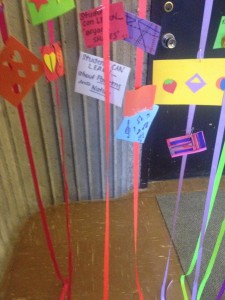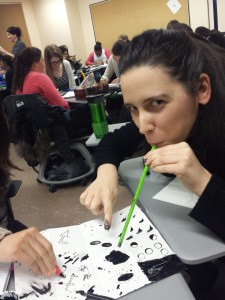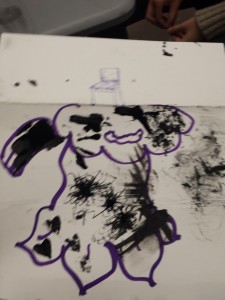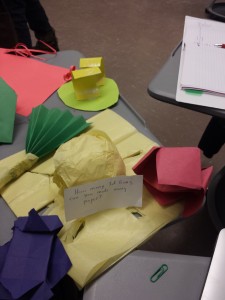Theories and Concepts
Intervention Art
We explored the artist Roadsworth, a contemporary artist who uses the streets to create art into something suprising. He has redesigned potholes, cracks in the streets, and other seemingly unimportant details we see in the everyday; making them into something intriguing and suddenly attracting.



We spoke of other intervention art examples such as writing “insert CV here” on a garbage can, yarn bombing metro seats and other funny or thought provoking messages portrayed through street art.
One way students can use such ideas is to give them chalk, and look around in the recess yard and create their own interventions.
We discussed “en masse” artists who offer white murals in strategic locations to allow anyone to make their own designs on it . The only rule is to use black when colouring. This creates a sense of unity on the murals.
Challenge: Principles of design pin
Similar to the previous class, our group was asked to design a pin featuring an element of design. Our group chose movement.

Students can learn about movements and sound. Sound relates to movement since sound, in its’ essence, consists of moving waves.
Challenge: Unconventional use of traditional media
Our challenge was to fold a paper into 16 equal parts. We were then given ink and required to make different markings on each square. We used ink and a fountain pen as a medium, but the twist was that we had to use the pen in unconventional ways.


Challenge: Exquisite corpse character and 5 different kinds of marks
For this challenge, our group was asked to fold a paper in 6 parts. Each group member was asked to design a part of the paper using ink as a medium. Once again, we were asked to use ink in our own unique way. When the paper unfolded our pictures united into a single character.

Challenge: 3d images

Themes and Prompts:
Seeing potential: We looked at “bottles of self” from previous students, on the outside it represented where they want to go or where they see themselves going and on the inside was how they are and how outside people perceive them. For younger children this activity was to create a creature represented on the outside, and create their habitat on the inside.
Power: Along with Roadsworth, we discussed students power in using unconventional ways of doing art in the classroom, away with paper! Why not paint rocks, design magnets, cover chairs in Jeso and redesign them, or make up a chess game.